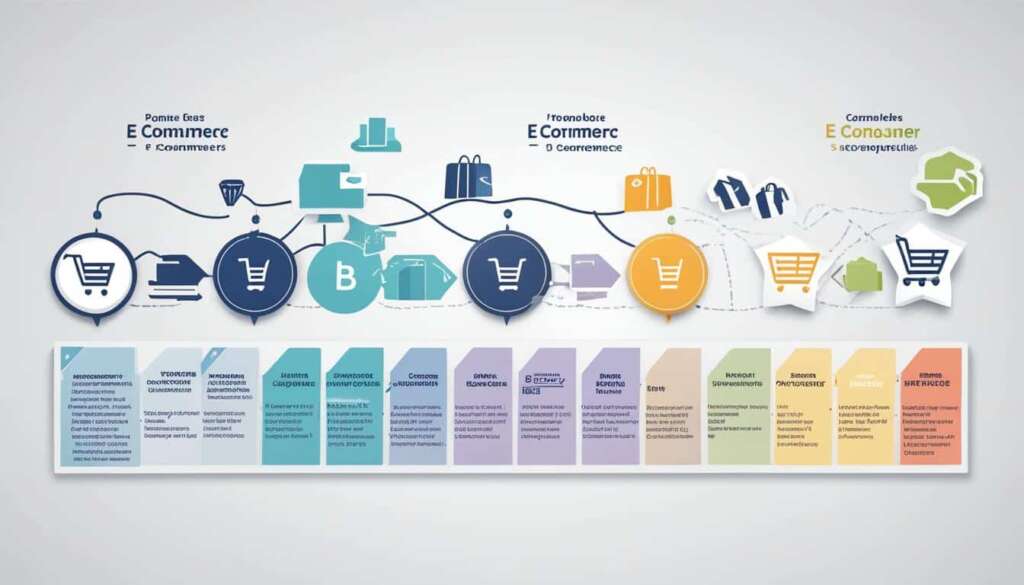Table of Contents
While e-commerce offers numerous advantages, it’s important to consider the potential disadvantages when venturing into online business. In this article, we will explore the drawbacks of e-commerce and shed light on the challenges that business owners may face in the digital marketplace.
E-commerce provides a cost-effective and scalable alternative to traditional storefronts, allowing businesses to reach a global audience with ease. However, it’s crucial to be aware of the drawbacks that come along with this digital business model. By understanding these disadvantages, entrepreneurs can make informed decisions and develop strategies to mitigate potential risks.
High Costs and Resource Requirements
When it comes to building an e-commerce website, businesses need to be prepared for the potential high costs and resource requirements involved. While e-commerce offers a convenient platform for selling products or services, it also demands significant financial investments and ongoing attention to maintain success.
Getting started with e-commerce often requires professional help, especially for businesses lacking technical expertise. Hiring web developers, designers, and digital marketers can be an expensive endeavor, particularly for small businesses with limited budgets. Professional services and tools need to be sourced to ensure the website is user-friendly, visually appealing, and optimized for search engines.
Once the initial setup is complete, ongoing resources and attention are crucial to ensure the e-commerce website functions smoothly and remains relevant in a competitive market. Adding new product information, updating pricing, and managing inventory become recurring tasks, demanding both time and manpower.
Security is another important aspect that necessitates resource allocation. As online threats evolve, continuous efforts must be made to safeguard customer data, implement reliable payment processing systems, and combat potential cyber attacks. This requires investing in secure web hosting, firewalls, encryption software, and regularly updating security measures.
Building and maintaining an e-commerce website can be a complex and resource-intensive process. However, when done right, the rewards can outweigh the costs by providing a platform for reaching a wider audience and enhancing business growth.
Financial Costs of E-Commerce
The financial costs of e-commerce encompass various aspects, including:
- Website development and design
- Web hosting and domain registration
- Digital marketing and advertising
- Payment processing fees
- Inventory management systems
- Security measures and software
For a clearer understanding of the costs involved, refer to the table below:
| Cost Component | Estimated Cost Range |
|---|---|
| Website Development and Design | £3,000 – £15,000+ |
| Web Hosting and Domain Registration | £50 – £500/year |
| Digital Marketing and Advertising | Varies based on campaign objectives |
| Payment Processing Fees | 2% – 5% per transaction |
| Inventory Management Systems | £30 – £300/month |
| Security Measures and Software | £500 – £2,000/year |
It is worth noting that these costs can vary significantly depending on the complexity of the website, the size of the business, and the desired features and functionalities. Furthermore, these costs represent just the initial investments and do not account for ongoing expenses related to maintenance, marketing, and security.
By understanding the financial commitments involved in e-commerce, businesses can plan and budget accordingly, ensuring that the potential returns outweigh the costs.
Potential Security Risks
One of the main concerns with e-commerce is the potential for security threats and data breaches. In an increasingly digital world, where sensitive customer data is stored and transmitted online, it is crucial for e-commerce businesses to prioritize website security to protect both their customers and their reputation.
Unauthorized Access and Compromise of Customer Data
Poor website security can expose vulnerabilities that allow unauthorized access to customer data. This can lead to the compromise of sensitive information such as names, addresses, payment details, and even passwords. Cybercriminals can exploit these weaknesses to carry out fraudulent activities or sell the stolen data on the dark web, causing financial and reputational damage to the affected customers and the e-commerce business.
Data Breaches Due to Payment Processor Issues
In addition to website vulnerabilities, e-commerce businesses rely on payment processors to securely handle online transactions. However, if payment processors experience data breaches or security flaws, customer payment information can be compromised. For example, hackers may gain unauthorized access to payment processing systems, allowing them to steal credit card details and other sensitive financial information.
“Data breaches in e-commerce not only result in financial losses but also erode customer trust and confidence.”
The Importance of Prioritizing Website Security
To mitigate the risks of e-commerce security threats and data breaches, it is essential for businesses to prioritize website security. Implementing robust security measures, such as SSL (Secure Sockets Layer) encryption, firewalls, and regular security audits, can help protect against unauthorized access and data theft.
Furthermore, staying informed about the latest security vulnerabilities and regularly updating software and plugins is crucial to ensure the ongoing security of an e-commerce website. By investing in security measures and taking proactive steps to protect customer data, businesses can mitigate the potential financial and reputational damage that can result from security incidents.
| Security Risk | Potential Impact |
|---|---|
| Poor website security | Loss of customer trust, financial losses due to data breaches |
| Payment processor issues | Compromised customer payment information, financial fraud |
Intense Competition and Marketing Challenges
E-commerce is a highly competitive space, with numerous online stores vying for customers’ attention. Standing out from the crowd and effectively marketing your e-commerce store can be a daunting task. To succeed in this competitive environment, it is imperative to develop and implement robust marketing strategies that capture the attention of your target audience.
One of the key challenges in e-commerce is the intense competition. With countless online stores offering similar products or services, it can be difficult to differentiate your brand and attract customers. Investing time and resources in market research is crucial to understanding your target audience’s needs and preferences, as well as identifying gaps in the market that you can capitalize on.
Once you have a deep understanding of your target audience, it’s time to develop a comprehensive marketing plan tailored to your e-commerce business. Effective marketing strategies can help you build brand awareness, drive traffic to your website, and ultimately increase sales. Utilizing various marketing channels, such as search engine optimization (SEO), pay-per-click (PPC) advertising, social media marketing, and email marketing, can help you reach and engage your target customers.
“In today’s highly competitive e-commerce landscape, it’s not enough to just have a great product or service. You need to effectively market and promote your business to cut through the noise and attract customers.”
Implementing SEO strategies can improve your website’s visibility in search engine results, driving organic traffic to your site. By optimizing your product descriptions, utilizing relevant keywords, and building high-quality backlinks, you can improve your search engine rankings and reach potential customers actively searching for products or services like yours.

Furthermore, investing in paid advertising, such as PPC campaigns, allows you to target specific audiences and drive immediate traffic to your website. Social media marketing provides opportunities to engage and interact with potential customers, build brand loyalty, and generate word-of-mouth referrals. Email marketing, on the other hand, enables you to nurture customer relationships, promote new products, and offer personalized discounts or incentives.
Developing effective marketing strategies for e-commerce also involves monitoring and analyzing your efforts for continuous improvement. Tracking key performance indicators (KPIs), such as click-through rates, conversion rates, and customer acquisition costs, can provide insights into the success of your marketing campaigns. By analyzing these metrics, you can identify areas for optimization and refine your marketing strategies accordingly.
In summary, intense competition in the e-commerce industry necessitates the development of effective marketing strategies to set your business apart from competitors. By understanding your target audience, implementing SEO techniques, utilizing various marketing channels, and constantly analyzing your efforts, you can overcome these challenges and carve a successful path in the e-commerce landscape.
Shipping and Logistics Difficulties
Shipping and logistics pose significant challenges for e-commerce businesses, particularly when it comes to managing B2C orders. The costs associated with shipping, packaging, warehousing, and logistics management can significantly impact the overall profitability of an online business. It is crucial for e-commerce entrepreneurs to understand the shipping challenges they may face and devise strategies to minimize costs and improve operational efficiency.
1. Cost of Shipping and Packaging
Shipping expenses can quickly add up for e-commerce businesses. The cost of transporting products to customers’ doorsteps significantly affects the bottom line. Additionally, packaging materials, such as boxes, bubble wrap, and packing tape, incur additional costs. Both domestic and international shipping costs can be burdensome, depending on the weight, size, and destination of the packages.
2. Warehousing and Inventory Management
E-commerce businesses often require dedicated warehouse space to store their inventory. Renting or owning a warehouse comes with its own set of expenses, including maintenance, utilities, and staff. Efficient inventory management is crucial to avoid running out of stock or holding excess inventory, both of which can be costly for the business. Utilizing warehouse management systems and optimizing inventory levels can help streamline operations and reduce warehousing costs.
3. Logistics Management and Fulfillment
Efficiently managing logistics and order fulfillment is essential for timely delivery and customer satisfaction. Coordinating the movement of products from the warehouse to multiple delivery locations requires careful planning and execution. Partnering with reliable shipping carriers, optimizing routes, and adopting automation technologies can help streamline the logistics process, minimizing delays and errors.
Shipping and logistics challenges can be daunting for e-commerce businesses. Effective strategies and optimizations can help minimize costs and improve operational efficiency.
Strategies for Minimizing Costs and Improving Efficiency
Here are some strategies that e-commerce businesses can implement to address shipping and logistics difficulties:
- Negotiate Shipping Rates: Establish partnerships with shipping carriers to negotiate competitive rates based on shipping volumes and frequency.
- Optimize Packaging: Use smaller packaging where possible to minimize dimensional weight charges. Utilize eco-friendly packaging options to reduce costs and meet sustainability goals.
- Implement Inventory Management Systems: Leverage inventory management software to monitor stock levels, track sales, and automate reordering processes.
- Explore Fulfillment Services: Consider outsourcing order fulfillment to third-party logistics providers. This can reduce warehousing costs and enable faster delivery through their established networks.
- Utilize Technology: Adopt logistics and warehouse management systems to streamline operations, track shipments, and optimize routes for efficient delivery.
By implementing these strategies, e-commerce businesses can navigate the challenges associated with shipping and logistics, reduce costs, and enhance customer satisfaction.
| Challenge | Impact |
|---|---|
| High shipping costs | Reduced profitability, increased product prices |
| Warehousing expenses | Additional overhead costs |
| Logistics management complexities | Operational inefficiencies, delayed deliveries |
| Packaging costs | Additional expenses, environmental concerns |
By addressing these challenges and implementing effective strategies, e-commerce businesses can overcome shipping and logistics difficulties, improve their bottom line, and deliver exceptional customer experiences.
Lack of Personal Interaction with Customers
One of the drawbacks of e-commerce is the lack of personal touch in the online shopping experience. Unlike in a physical store, where customers can engage in face-to-face interactions and receive immediate assistance, e-commerce stores often lack the ability to provide personalized recommendations or address specific customer needs.
The impersonal nature of e-commerce can create challenges in building trust and loyalty with customers. Without the opportunity for personal interaction, customers may feel disconnected from the brand and perceive the online shopping experience as cold and transactional. This lack of personal touch can hinder the establishment of strong customer relationships, which are critical for long-term success in e-commerce.
However, there are strategies that e-commerce businesses can employ to mitigate the impersonal nature of online shopping and foster a sense of personal connection with customers. One approach is to enhance the customer experience through personalized communication and tailored recommendations based on their previous purchases or browsing history.
Strategies for Building Customer Trust and Loyalty
- Implement Live Chat: By offering real-time support through live chat, customers can have their questions answered immediately, replicating the convenience of in-person assistance.
- Personalize Product Recommendations: Utilize customer data and browsing history to provide personalized product recommendations, creating a more tailored and engaging shopping experience.
- Offer Virtual Consultations: For industries that require expert advice or consultation, consider offering virtual consultations through video calls or chat platforms to provide customers with personalized guidance.
- Invest in Customer Support: Develop a knowledgeable customer support team that can provide responsive assistance and empathetic service, ensuring that customer concerns and issues are addressed promptly.
- Create Interactive Content: Engage customers with interactive content such as quizzes, polls, and social media contests to encourage participation and foster a sense of community.
Providing a personalized and interactive experience can help bridge the gap between e-commerce and traditional retail, strengthening customer relationships and building brand loyalty.

| Drawback | Solution |
|---|---|
| Lack of face-to-face interaction | Implement live chat and virtual consultations |
| Impersonal online shopping experience | Personalize product recommendations and create interactive content |
| Difficulty establishing trust and loyalty | Invest in responsive customer support and develop a sense of community |
Conclusion
While e-commerce offers numerous advantages, it’s crucial to consider the potential disadvantages and drawbacks before diving into online business. In this article, we have explored the various downsides of e-commerce, highlighting the need for careful planning and strategic decision-making.
Firstly, building and maintaining an e-commerce website can come with substantial costs and resource requirements. From professional web development to ongoing security maintenance, these financial investments are essential for a successful online presence.
Secondly, the security risks associated with e-commerce cannot be underestimated. The possibility of data breaches and unauthorized access requires businesses to prioritize website security and implement robust security measures.
Additionally, the intense competition in the e-commerce industry poses marketing challenges. Standing out among competitors and effectively promoting your online store requires strategic marketing campaigns and unique value propositions.
Furthermore, shipping and logistics difficulties can be significant obstacles for e-commerce businesses. The cost of shipping, warehousing, and logistics management may impact profit margins, and finding efficient solutions is crucial.
Lastly, the lack of personal interaction with customers is a notable drawback of e-commerce. Providing personalized assistance and building customer trust and loyalty becomes more challenging in a virtual environment.
Considering these disadvantages, it’s essential for aspiring e-commerce entrepreneurs to carefully weigh the pros and cons, taking proactive steps to mitigate challenges and maximize the benefits of online business.
Overall, while e-commerce presents numerous opportunities, acknowledging and addressing the potential drawbacks is key to navigating the competitive landscape and creating a successful online venture.
FAQ
What are the disadvantages of e-commerce?
E-commerce has several drawbacks, including high costs and resource requirements, potential security risks, intense competition and marketing challenges, shipping and logistics difficulties, and the lack of personal interaction with customers.
Why can building an e-commerce website be expensive?
Building an e-commerce website can be expensive, especially if professional help is needed. Additionally, ongoing maintenance and the addition of product information and security measures require ongoing resources and attention.
What are the potential security risks of e-commerce?
E-commerce is prone to security threats, such as unauthorized access and data breaches. Poor website security and payment processor issues can compromise sensitive customer data.
How does competition affect e-commerce businesses?
E-commerce is a highly competitive space, with numerous online stores vying for customers’ attention. This makes it challenging to effectively promote and market your e-commerce store, requiring you to develop effective marketing strategies to stand out.
What are the shipping challenges for e-commerce businesses?
Shipping can be a major challenge for e-commerce businesses, with costs of shipping, packaging, warehousing, and logistics management adding significant expenses to the business. Strategies for minimizing costs and improving efficiency are crucial.
What is the drawback of the lack of personal interaction in e-commerce?
One of the drawbacks of e-commerce is the lack of personal interaction with customers. Unlike in a physical store, e-commerce stores do not allow for face-to-face interactions or immediate assistance and personalized recommendations.













